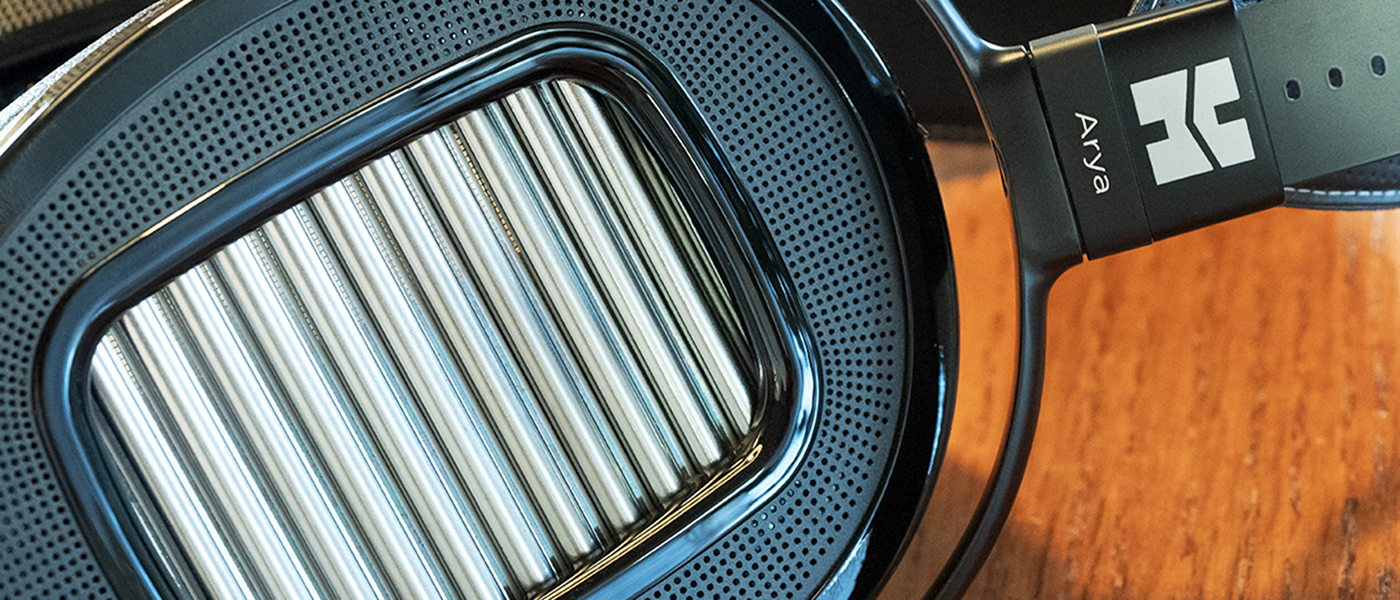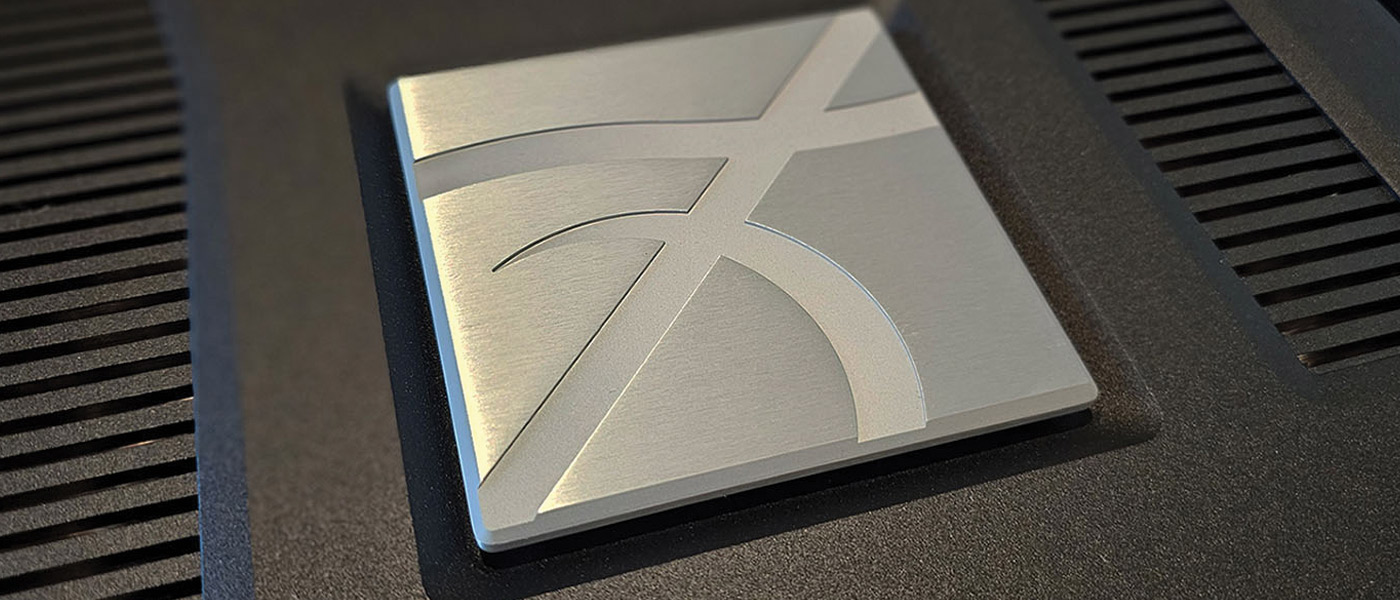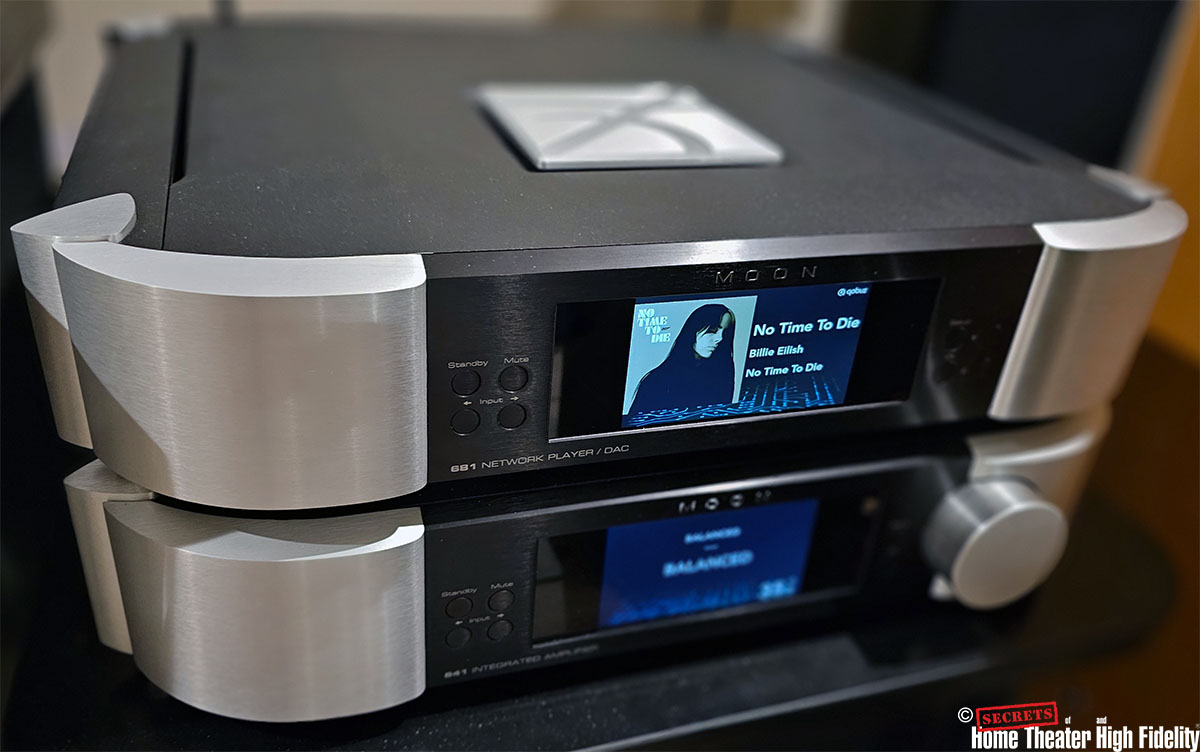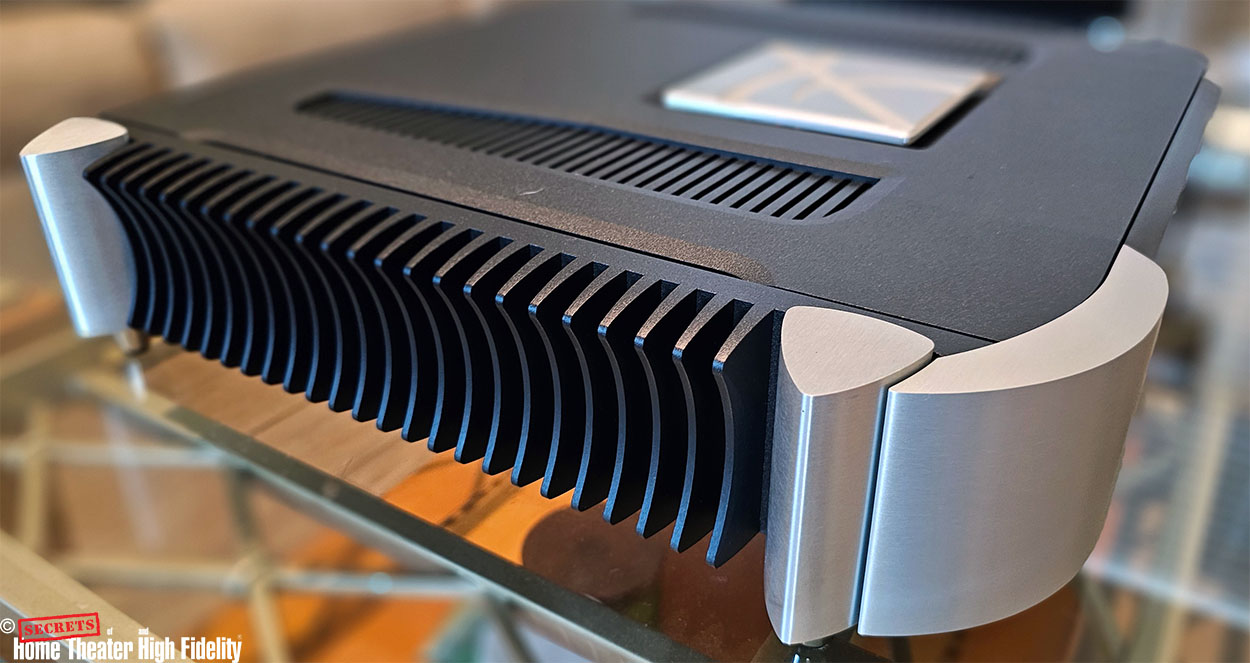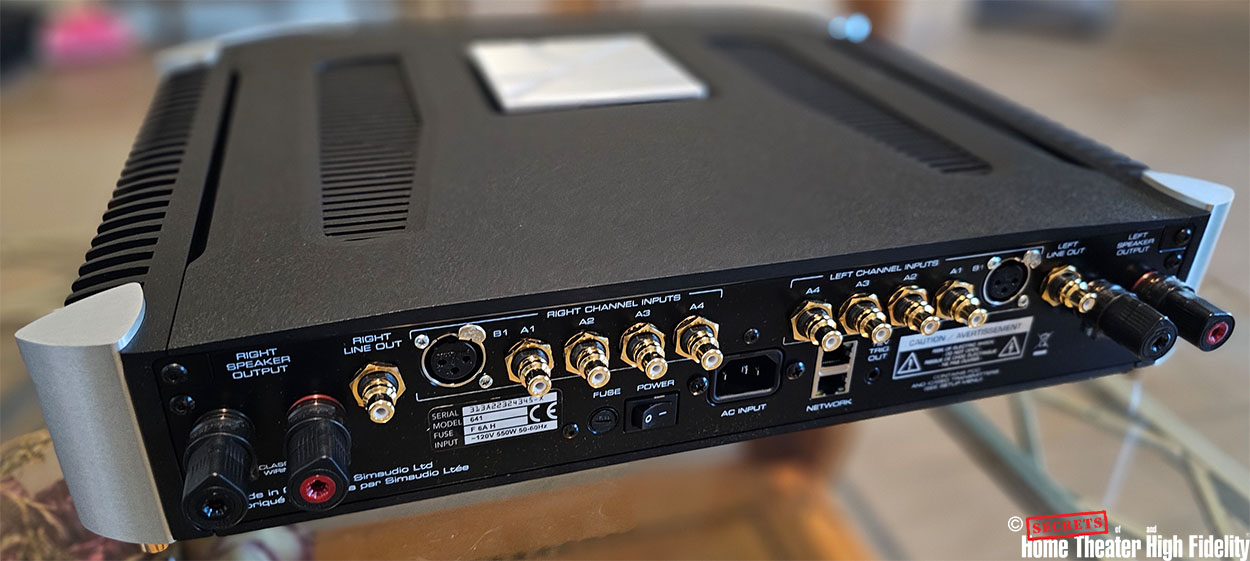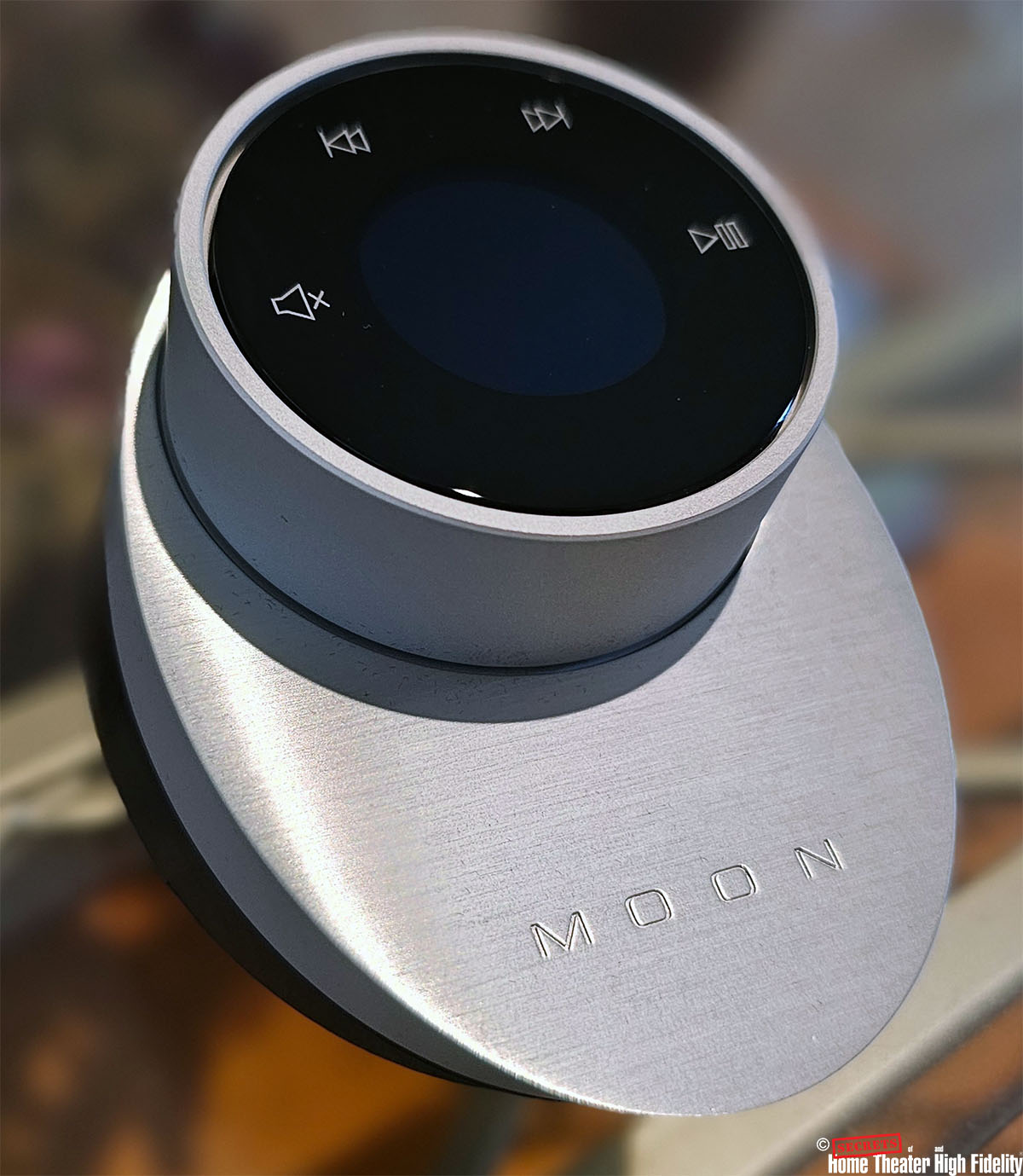The North Collection represents the culmination of MOON’s more than 40 years of experience in creating premium hi-fi products. A quick glance at the products from this collection reveals aesthetically stunning designs that align well with their high-end status. These products exude prime quality through their craftsmanship alone. This review will focus on two products from MOON’s North Collection: the MOON 681 network player/DAC and the MOON 641 integrated amplifier. They complement each other both functionally and aesthetically, as they share similar chassis dimensions and exterior design traits. The review will further highlight the features and sonic performance that these products offer.
MOON 681 network player/DAC
- AES/EBU, coaxial, optical, USB, and HDMI ARC input connectivity.
- MiND2 streaming platform.
- Roon-Ready.
- DAC processing up to 32-bit/384-kHz PCM and DSD256 (streaming and USB).
- 4.3” LCD display.
- BRM-1 remote control and MiND Controller app
MOON 641 integrated amplifier
- Balanced (XLR) and unbalanced (RCA) inputs.
- Unbalanced preamplifier output.
- M-VOL3 electronic gain volume control.
- 4.3” LCD display.
- Dual-mono amplifier configuration capable of producing 125 W/channel (into 8 Ohms) or 250 W/channel (into 4 Ohms).
- BRM-1 remote control.
Simaudio, which started out as Sima Electronique, was founded in 1980 with a mission to create equipment for high-performance music reproduction. Drawing from years of experience in the audio industry, Simaudio launched the MOON series in 1997, showcasing its reference-grade audio products.
The MOON products featured in this review represent the latest advancements in Simaudio’s research and development for high-performance music reproduction. These products are part of MOON’s North Collection: the MOON 681 network player/DAC (priced at $12,000) and the MOON 641 integrated amplifier (priced at $11,000). While they are not in the budget audio products category, a closer look reveals the superior quality of materials and craftsmanship, which surpasses that generally found in comparable audio equipment.
Simaudio seems to place a strong emphasis on ensuring the safe delivery of their products. These MOON products arrived very well packaged. Their packaging was among the best I had ever encountered for audio equipment. The products appeared to be adequately safeguarded against shipping impacts within their well-padded boxes.
Dual-Mono configuration
Output Power (Stereo 8 Ω):
125 W
Output Power (Stereo 4 Ω):
250 W
Line level inputs:
4 unbalanced (RCA), 1 balanced (XLR)
Line level output:
1 unbalanced (RCA)
Speaker level output:
1 pair
Input Sensitivity:
300 mV – 6 V
Input Impedance:
22 kΩ
Gain:
40 dB
M-VOL3 3rd generation electronic gain control
Frequency Response:
2 Hz – 90 kHz (+0 dB / –3 dB)
Crosstalk:
–109 dB
Signal-to-Noise Ratio:
109 dB
Total Harmonic Distortion + Noise:
0.008% (@ 1 W), 0.003% (@ 125 W)
Damping Factor:
700
4.3” LCD graphic color display
BRM-1 Intelligent Remote Control
Power Consumption (Idle):
38 W
Power Consumption:
37 W (Full Power Standby), 2.5 W (Low Power Standby)
Shipping Weight:
57.5 lbs. (26 kg)
Dimensions (W x H x D):
18.95” x 4.03” x 18.32” (48.1 cm x 10.2 cm x 46.5 cm)
MSRP:
$11,000
Company:
SECRETS Tags:
Simaudio, Moon by Simaudio, MOON, 681, Network Player, DAC, 641, Integrated Amplifier
Digital signals type:
PCM and MQA (up to 32-bit), DSD
Digital inputs:
1 x AES/EBU (PCM up to 192 kHz), 2 x coaxial (PCM up to 192 kHz), 2 x optical (PCM up to 96 kHz), 1 x USB (PCM up to 384 kHz, DSD up to DSD256), 1 x HDMI ARC (PCM up to 192 kHz)
Fully Balanced configuration
Mind2 software streaming module (PCM up to 384 kHz, DSD up to DSD256)
Analog outputs:
1 x XLR, 1 x RCA
Analog Output Level:
2 Vrms / 3.5 Vrms / 6.5 Vrms (adjustable gain)
Crosstalk:
–125 dB
MHV Moon Hybrid Volume Control
Frequency Response:
2 Hz – 100 kHz (+0 dB / –3 dB)
Signal-to-Noise Ratio:
125 dB
Dynamic Range:
125 dB
Total Harmonic Distortion + Noise (@ 0 dBFS):
0.0003%
4.3” LCD graphic color display
BRM-1 Intelligent Remote Control
Power Consumption:
15 W (Idle), 12 W (Full Power Standby), 5 W (Low Power Standby)
Shipping Weight:
40 lbs. (18 kg)
Dimensions (W x H x D):
18.95” x 4.03” x 16.80” (48.1 cm x 10.2 cm x 42.7 cm)
MSRP:
$12,000
Secrets Sponsor
After unboxing, I was immediately impressed by the sophisticated case designs of these MOON products. Their machined aluminum panels, featuring accented curved corners with a two-tone finish of brushed black and smooth silver, are meticulously crafted and exemplify superior quality. They are heavier than typical similar devices and seemingly built like a tank. These components should not be concealed in a dark corner, though there is nothing to prevent such an arrangement if desired. However, if it were me, I would display them in an open space for visibility, as their appearance alone exudes a sense of pride in ownership.
The MOON 641 is an integrated amplifier in the traditional sense, meaning it can only handle the switching of analog signals. The 641 can accept five line-level inputs (4 unbalanced, 1 balanced) and provides one speaker-level output. Line-level unbalanced output is also available for use with an external amplifier or for subwoofer line-level connection. The MOON 641 employs a dual-mono configuration class AB amplifier capable of producing 125 W/channel into 8 Ohm loads, which doubles into 250 W/channel into 4 Ohm loads.
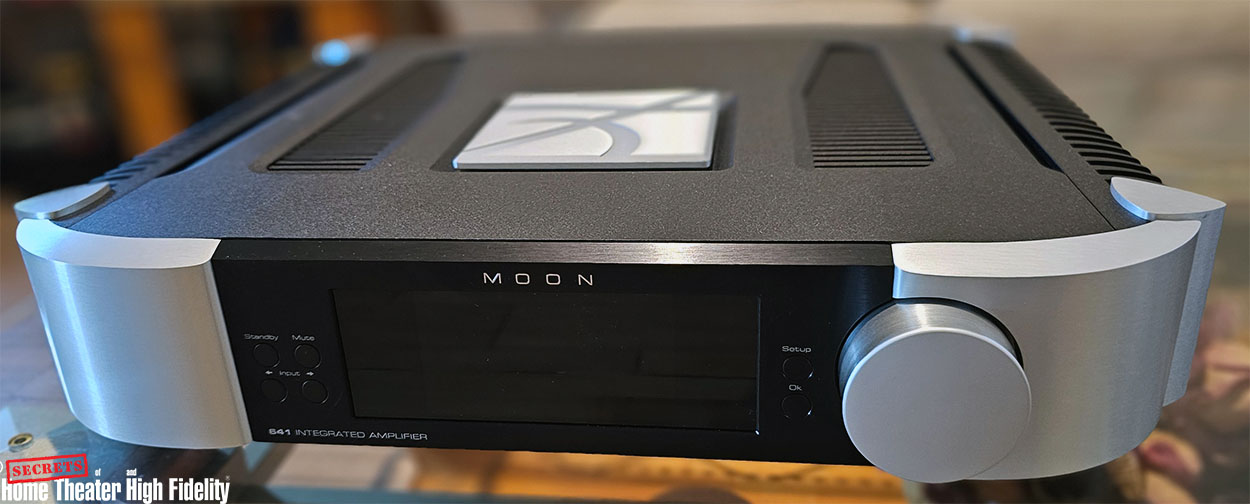 MOON 641 Integrated Amplifier front view
MOON 641 Integrated Amplifier front view
The MOON 641 amplifier features MOON’s proprietary M-VOL3 high-precision volume control system, which utilizes sophisticated circuitry to ensure minimal impact on the audio signal and allows for very precise volume adjustments with a large number of steps. Additionally, the amplifier includes a 4.3” LCD color graphic display on its front panel and can be linked to the BRM-1 Intelligent Remote Control via Bluetooth wireless connectivity.
The front panel of the MOON 641 looks clean and uncluttered. It sports a centrally positioned LCD display, accompanied by a round volume knob on the right side (when viewed from the front). Additionally, there are flat push buttons located to the left and right of the display, consisting of the standby/on button, menu navigation buttons, and input selection buttons. While maintaining its functionality, the entire chassis incorporates design elements such as curved ribbed heatsinks on the side panel, enhancing the unit’s aesthetic appeal. The vents and the square MOON logo plate on the top panel give the impression of the hood of a luxury sports car.
The BRM-1 is a uniquely designed, oval-shaped remote control that features a rotary knob surrounding a touch panel at the center, which is backlit and includes a small OLED display. The base of this splash-proof remote is constructed from durable plastic, while its upper section is made of aluminum. The BRM-1 is ergonomically sized to fit comfortably in an adult’s hand and can be held during use or conveniently placed on a nearby surface. I typically just laid it on the armchair or the section divider of my sectional sofa. The remote’s knob rotation is smooth, similar to the knob on the front panel of the unit. It is powered by a rechargeable Li-ion battery and communicates with the main unit via Bluetooth. The standard USB-C charging port is located on the base of the remote. When linked to the 641, the rotary knob of the BRM-1 not only replicates the function of the volume knob on the front panel of the 641, but it can also function as an input scroller by double-tapping the touch panel. Using the BRM-1 remote may take some getting used to, but once I became accustomed to it, I certainly enjoyed the experience.
The MOON 681 is a DAC equipped with music streaming capability. It features MDE-1 (MOON DAC Engine 1) technology for digital-to-analog conversion, using an FPGA (Field Programmable Gate Array) to re-clock and condition the digital signal. Combined with ultra-high-quality picosecond (one trillionth of a second) clocks, it reduces timing errors (jitter) below the threshold of audibility. The 681 utilizes the ES9028Pro chipset in a fully balanced configuration with four monaural DAC outputs per channel, which are then summed for lower noise and distortion. The DAC can process PCM signals up to 32-bit/384-kHz (including MQA) and DSD signals up to DSD256.
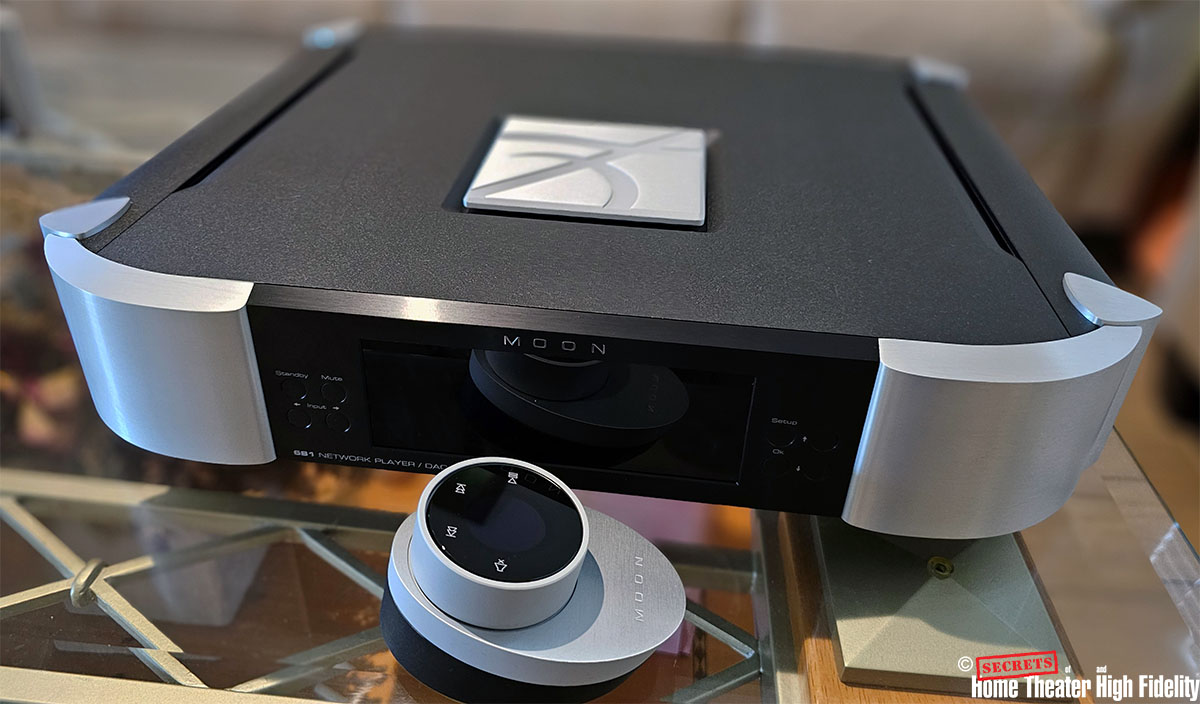 MOON 641 network player/DAC with BRM-1 remote control
MOON 641 network player/DAC with BRM-1 remote control
The MOON 681 offers versatile input connectivity options, which include USB, optical, coaxial, HDMI ARC, and AES/EBU. Analog outputs are available in both balanced and unbalanced formats. The device is Roon Ready and supports a wide range of streaming features, including UPnP, AirPlay 2, Spotify Connect, Tidal Connect, Deezer, Qobuz, Bluetooth aptX, and internet radio. It can connect to the network through a wired (LAN) or wireless (Wi-Fi) connection. The streaming feature in the MOON 681 is built upon MOON’s own MiND2 platform, which can be conveniently connected and controlled using the MiND Controller app, available for free download on Android or iOS. The MiND Controller app can also be used to control the 681 operations, such as switching inputs and turning the device on/off. The MiND Controller app has an appealing and user-friendly interface, with a minimal learning curve for comfortable use.
 MOON 641 network player/DAC rear panel
MOON 641 network player/DAC rear panel
The MOON 681 also features a 4.3” full-color LED display like the MOON 641, which shows the selected input or track information (in the streaming mode). I found this display to be appealing, adding a lively appearance to an otherwise static device. You can always turn off the display if you feel it is distracting from your listening experience. Additionally, like the 641, the MOON 681 is supplied with the BRM-1 Intelligent Remote Control. When linked to the 681, the BRM-1 can be used to switch inputs and control streaming playback (skip forward/backward, pause, stop, and play).
Throughout most of the review period, I stacked the MOON 681 network player/DAC on top of the MOON 641 integrated amplifier and linked them using a balanced connection. While primarily utilizing the MOON 681 as a streamer, I also evaluated its DAC functionality by feeding it with various sources. These included the Auralic Aries G1 streamer and the PS Audio PerfectWave CD Transport, both connected to the MOON 681 via coaxial digital inputs. Additionally, I employed the Eversolo DMP-A8 streamer DAC as an alternative analog source for the MOON 641. The speakers used for this review were my trusty Revel Ultima Studio speakers (nominal impedance 6 Ohms).
Prior to initial use, I connected the MOON 681 to my home Wi-Fi network by accessing and navigating the unit’s setup menu system using the push buttons on the front panel. The product manual outlines the setup process clearly. However, the 681’s menu system is straightforward and logical, allowing me to continue setting up the unit without necessarily referring to the manual. Another important setting is the analog output type, which can be set to Variable or Fixed. Since I used the MOON 641 to control the playback volume, the analog output from the MOON 681 was set to Fixed. I also went through the Bluetooth pairing process to activate the supplied BRM-1 remote controls for use with the associated units.
After setting up the hardware and making the necessary cable connections, I installed the MiND Controller app on my iPad. The user interface of the app was generally good, and it did not take long for me to navigate comfortably through its various functions. The streaming control using the app was typically swift and loading and modifying the queue were quite straightforward. I appreciated being able to access the music files stored on my NAS using the app. Most of the time during the review, I used the app to control the operation of the MOON 681, such as changing input selection and turning the unit on/standby. Apart from some occasional glitches, operating the MOON 681 through the app typically ran smoothly. The glitches were mostly associated with the occasional loss of network connectivity when waking up from standby, causing the device to appear as MOON 681 (unconfigured) in the app. Switching the device off and then on again after a few seconds (from the on-off switch on the rear panel) typically resolved the situation, allowing it to reconnect to its stored network configuration. Given the infrequent occurrence of the glitches, I did not find them overly concerning. A firmware update could probably fix it.
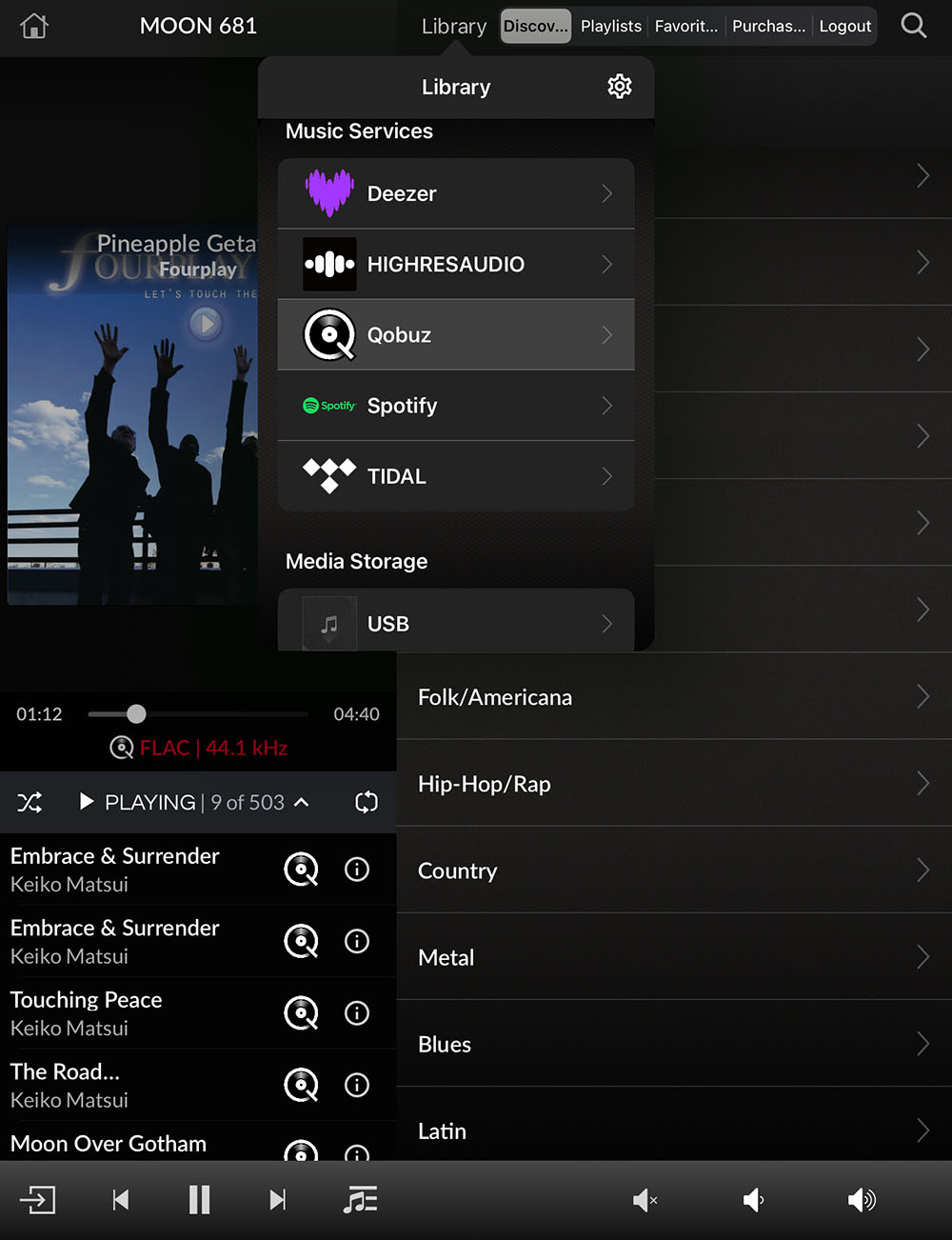 MiND Controller app screenshot
MiND Controller app screenshot
Individually, the MOON 681 network player/DAC and MOON 641 integrated amplifier are outstanding performers in their respective categories. Although I predominantly evaluated them as a pair, I also tested them separately at different times within my system and consistently found the results to be satisfactory. Undoubtedly, each of these MOON components has the potential to significantly enhance the overall performance of a hi-fi system.
The 641 integrated amplifier always presented music with great balance across the audible frequency spectrum. Its sonic presentation exhibited a great sense of coherence and was rich in texture. Even at high volumes, the amplifier maintained its composure, effectively handling the dynamic peaks and troughs of the music. The 641 could deliver bass in a brute-force fashion (punchy and impactful), while also producing fine-quality midrange and treble. The overall musicality of the 641 was compelling, encouraging me to increase the playback volume for a more immersive listening experience.
The MOON 681 network player/DAC impressed me with its first-rate DAC performance and effective streamer functionality. The 681’s rendition of dynamics and details was exceptional, making the music sound fluid with a solid pace and rhythm. Never once did I feel that the presentation was overly lean, harsh, or lifeless.
Used together, the MOON 681 and 641 complement each other extremely well and form a formidable combination. Although they come with a significant cost, their excellent synergy highlights their true high-fidelity capabilities, providing listeners with top-notch sonic performance. I found that transparency and palpability were the sonic attributes that this MOON 681 and 641 combo particularly excelled in. They were also highly revealing of the nuances in the various sources, allowing me to discern the different sonic characteristics among them. Irrespective of the source employed, this MOON combo appeared to render the speakers virtually invisible, seamlessly immersing me in its vivid portrayal of a three-dimensional musical atmosphere. This setup demonstrated an exceptional ability to produce a realistic sense of musical envelopment through its presentation.
 Imelda May’s Life Love Flesh Blood (2017) album cover
Imelda May’s Life Love Flesh Blood (2017) album cover
Imelda May, “Life Love Flesh Blood”
The palpability and spatial rendition of the track Call Me from Imelda May’s Life Love Flesh Blood (2017) album streamed from Qobuz through the MOON 681 and 641 combo were about the best I had ever listened to in my setup. Imelda May’s voice sounded natural and full-bodied with an excellent center image focus. The combo projected an intimate musical stage with a width extending beyond the speakers’ boundaries. The precise locations depicting layers of stage depth of the accompanying instruments seemed more vivid than ever before. The three-dimensionality of the whole presentation definitely elevated the level of enjoyment I got from listening to this track.
 Green Day’s Greatest Hits: God’s Favorite Band (2017) album cover
Green Day’s Greatest Hits: God’s Favorite Band (2017) album cover
Green Day, “Greatest Hits: God’s Favorite Band”
The exceptional transparency of the MOON 681 and 641 combo translated into a see-through quality in its sonic delivery, unveiling the raw essence of the recording in a good way. As a result, the music sounded rich in texture and vibrant. These traits were especially beneficial for the rock musical genre. Tracks like Wake Me Up When September Ends by the rock band Green Day from their album Greatest Hits: God’s Favorite Band (2017) sounded electrifying with all the rawness and textures. The depiction of micro and macro dynamics in the track was impeccable. The bass impacts from the kick drums that were featured heavily in the track were conveyed convincingly. Combined with the combo’s excellent soundstage rendition, this added liveliness to the overall presentation.
 John Williams Live in Vienna (2020) album cover
John Williams Live in Vienna (2020) album cover
Anne-Sophie Mutter, John Williams, and Vienna Philharmonic, “John Williams Live in Vienna”
The MOON combo also exhibited prowess in the playback of large-scale music. The combo produced gloriously the live orchestral rendition of Raider’s March from John Williams Live in Vienna album (2020) through its excellent conveyance of dynamics and rhythm. Its adeptness in navigating through the soft and slow as well as energetic and loud passages in the music was mesmerizing, allowing me to truly feel the emotions of the music. The MOON 681’s spatial rendition of this track was about the most vivid I had ever experienced, enabling me to pinpoint the location of the various instrument sections in the wide and deep soundstage that it projected.
Secrets Sponsor
The MOON 681 network player/DAC and 641 integrated amplifier are premium products exemplifying superb craftsmanship, exquisite designs, and, most importantly, first-rate sonic performance, substantiating their price point.
- Exquisite look and first-rate build quality.
- Good input/output coverage for digital and analog sources.
- MOON 683’s versatile DAC processing: PCM signals up to 32-bit/384-kHz (including MQA) and DSD signals up to DSD256.
- 4.3” LCD display on the front panel.
- The BRM-1 remote control.
- Top-notch all-around sonic performance.
- Nothing of consequence.
Simaudio’s MOON 681 and 641 are designed to impress. From start to finish, this MOON combo never failed to impress me. Initially, these components caught my attention with their stunning design and excellent build quality. Then throughout the review process, they impressed me with their superior sonic performance. Individually, each of these devices is an outstanding performer. When paired together, they seem to elevate the overall sonic results. While value is relative, I believe the adage “you get what you pay for” is particularly relevant to these MOON products. This MOON combo exhibits excellent craftsmanship and design, and more importantly, top-notch sonic performance, which collectively justify its worth. If the asking price is within your budget, I highly recommend checking out these MOON components. Their overall superior quality might win you over.


